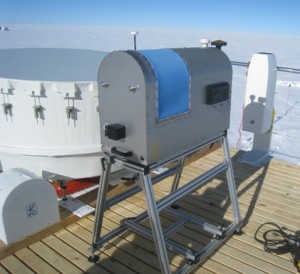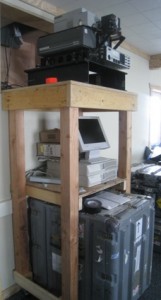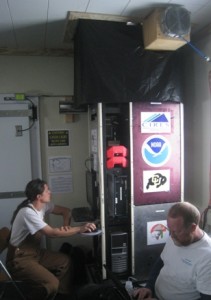 We’ve had some success lately at getting our instruments up and running. When the carpenters finished their work, we moved in our boxes (probably 40 of them) and exploded them all over the space. It was a bit chaotic for a few days, but then started developing into a nice observatory. A sampling of our instruments is shown here (clockwise, starting top left):
We’ve had some success lately at getting our instruments up and running. When the carpenters finished their work, we moved in our boxes (probably 40 of them) and exploded them all over the space. It was a bit chaotic for a few days, but then started developing into a nice observatory. A sampling of our instruments is shown here (clockwise, starting top left):
* Polar Atmospheric Emitted Radiance Interferometer (P-AERI): sticks through the wall and looks up through a hatch, measures spectral infrared radiation that provides information on cloud micrrophysical properties, temperatures, and trace gases.
*Millimeter Cloud Radar (MMCR): Computers and transmitter live inside the building, while the antenna sits on top. Provides information on cloud locations, cloud microphysical properties, and cloud-scale atmospheric dynamics.
* Micropulse Lidar (MPL): observes the atmosphere and clouds through a window in the ceiling of the MSF, providing information on cloud locations and microphysical composition.
*Ceilometer: Provides a robust measurement of the ceiling, or effectively the cloud base. This information will be very useful not only for our science but also for airplanes as they attempt to land at Summit.
* Microwave Radiometer (MWR) – looks like a grey and blue mailbox: We have two of these making measurements at a number of frequencies around 20, 30, 50, 90, and 150 GHz, which tells us about atmospheric moisture, condensed liquid water, and temperature.
* Cloud-Aerosol Polarization and Backscatter Lidar (CAPABL): the rebirth of the depolarization lidar from SHEBA. Tells use about cloud locations, phase, and possibly something about ice particle orientation.




